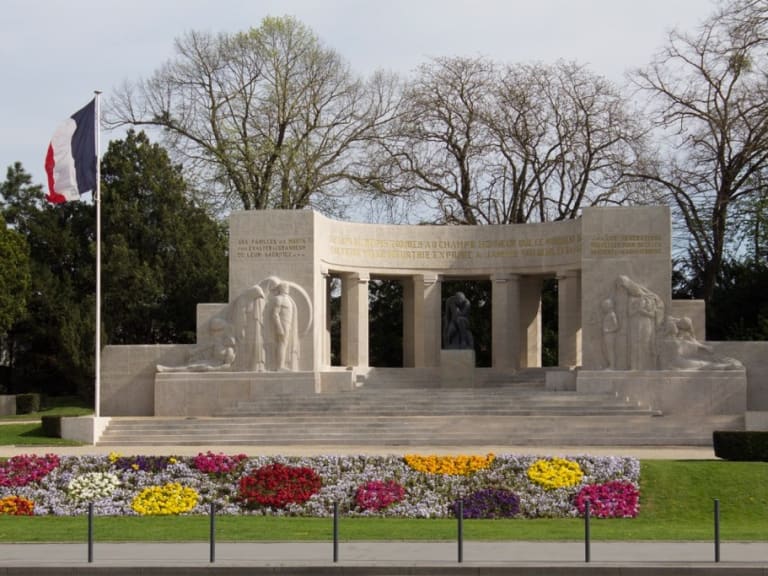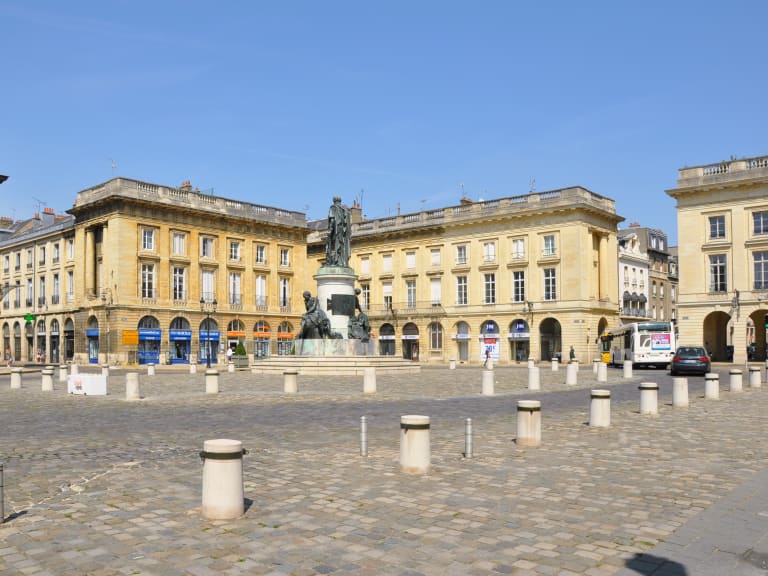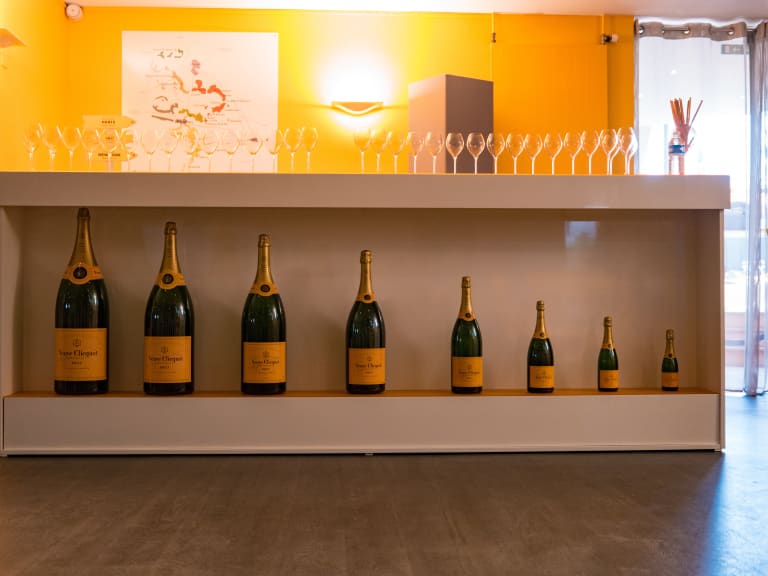More about: Reims in 3 Days: a guidebook for getting the most out of your visit
Reims is a city bursting with energy and character, and three days is barely enough time to scratch the surface of all it has to offer - whether you're a history buff or a foodie, especially champagne lovers, there's something for everyone here. So get ready to lose yourself in the stunning architecture, welcoming people and lively atmosphere that make Reims such a special place.
And, as you wander its streets and explore its hidden gems, take a moment to appreciate the legendary champagne that flows through its veins, reminding us that life is meant to be celebrated. Embrace the spirit of Reims and soak up its endless charms with this 3-day mapped itinerary so you won't miss any of the best things to do and see in Reims.
Day 1: Explore the northern part of Reims city centre

At the heart of this picturesque region of Champagne-Ardenne lies charming Reims, famous for its cultural and architectural monuments, its extraordinary gastronomy and, of course, for being the French city of consecrations and champagne bubbles.
On the first day of your tour, I propose a 9-stop walk around the emblematic sites of the unofficial land of champagne. The route covers a radius of 2.5 kilometres, which you can follow using this map. It's quite simple and can be done on foot, by bike or by public transport. Also, if you feel like getting to know each place in detail, you can sign up for a private tour of Reims. That said, let's get started!
The Tau Palace
A must-see is the Palais de Tau, the former residence of the archbishops of Reims, which now houses the Musée de l'Oeuvre de Notre-Dame and is the venue for the banquets commemorating the consecrations.
This impressive building is both historic and visually stunning. It has a unique collection of objects that reveal the city's past, including one of the largest collections of tapestries in the world, making it one of the UNESCO World Heritage Sites in the Gallic area.
The Carnegie Library in Rheims
The Carnegie Library, funded by the Scottish-American philanthropist Andrew Carnegie, was built in Art Deco style and boasts an impressive décor evoking the golden age of the United States in the 1920s.
This public library is one of a group of some 2500 Carnegie libraries built in the 19th and 20th centuries. In addition to being a place for reading and study, the Carnegie Library exemplifies Carnegie's legacy and his commitment to education and access to information for all.
The Cathedral of Reims
The Cathedral of Notre-Dame de Reims, better known as the Cathedral of Reims or the Cathedral of Notre-Dame, is one of the most beautiful cathedrals in France. Although it has often been overshadowed by its Parisian sister, it boasts historical value, as all French kings were crowned here.
The interior is notable for its nave lighting and exquisite 13th century stained glass windows. The axial chapel displays blue stained glass windows designed by Marc Chagall and magnificent sculptures of angels with their wings outstretched to envelop the city.
Visit Notre-Dame Cathedral, a magnificent building built in the 13th century. It is one of the country's most impressive masterpieces of Gothic architecture and was rebuilt in record time after the devastation of almost 80% of the city during the First World War. It is also a testament to the skill and talent of the craftsmen who created it with intricate carvings and breathtaking stained glass windows that will take your breath away.
La Place royale

The Place Royale, built in 1757, was built in honour of Louis XV, as is evident from its central monument created by Jean-Baptiste Pigalle in 1765. This square, with its typical 18th century architecture, has arcades and roofs with horizontal balustrades.
In the background, the pediment of the former Hôtel des Fermes, now the seat of the county council, refers to the commercial activities of Reims. Passing through this point is quick, but the monument is well worth the effort.
The cryptoporticus
The cryptoporticus, located in the sacred area of the forum, has a monumental semi-underground portico surrounding it. Following archaeological studies of the building's arched mud bricks, scholars believe that the point of origin of this monument dates back to the 1st century AD.
Although its exact function is unknown, various theories suggest that it may have been used as a meeting place, a place of debate, a promenade or a covered market in connection with the nearby shops. What is known is that its entrance indicates a different use to the surrounding architecture, and its height of over 5 metres makes it an impressive structure, worthy of being incorporated into your memories of your trip to Reims.
The Musée-Hôtel Le Vergeur
The history of the Musée-Hôtel Le Vergeur dates back to the 13th century, when markets were held in the Forum. The remains of the Gallo-Roman forum can still be seen today. The hotel's two levels of vaulted cellars indicate that it was once used for the Champagne still wine trade.
In 1895, Count Werlé, president of the House of Veuve Clicquot-Ponsardin, gave the property to one of his partners who restored the great Gothic hall. The Hotel le Vergeur then took the name of Maison Champagne Couvert. It later became the home of the photographer Hugues Krafft and today houses a rich art collection in its museum.
The Hôtel de ville of Reims

Next up is another photo stop, this time at the Hôtel de ville de Reims. It is a place that combines history, culture and architectural beauty. Since its construction in 1499, this majestic building has been the seat of municipal institutions and remains an important symbol of the city.
With its square design and symmetrical wings, this hotel encloses a central courtyard, where the statue of René de Saint-Marceaux, representing the vine and the champagne foam, is located.
The Boulingrin district
It's time for lunch and on the way to your next stop you pass through the pretty and trendy Boulingrin quarter, the place for art deco, street art and gastronomic escapades.
Here you can sample specialities such as the orange rind cheese produced in Langres or the creamy Chaource, similar to the popular Camembert, in any of its gourmet shops. In addition, the charcuterie Bruno Herbin, listed as one of the best in the country, offers the best Reims ham in the region, thanks to its secret combination of Provençal herbs. And let's not forget the variety of restaurants in the surrounding area. Take your time and recharge your batteries.
The Porte de Mars
The Porte de Mars in Reims is an impressive historical monument worth visiting. At 30 metres wide and more than 12 metres high, the gate remains almost intact despite its history dating back to the 2nd century. Its four arches represent the four entrances to the city of Durocortorum, the ancient name of Rheims.
In addition, the interior of the arches is beautifully decorated and features a figure of the she-wolf suckling the twin founders of Rome, Romulus and Remus. Around the park where it is located, there are other places of interest such as the Fountain of the Hautes Promenades.
This is the perfect place to end the afternoon, and best of all, there is also a good range of terraces and bars where you can go for dinner and enjoy a good champagne.
Day 2: Wineries and vineyards in Epernay and Hautvillers

On the second day of your trip I propose one of the best day trips from Reims to visit the vineyards of Epernay and Hautvillers.
In this case the stops will vary depending on the operators, however, they often have some points in common: they last between 7-8 hours, they cover the most famous vineyards in the area, they offer a service with lunch and transfers included and of course you will be able to taste champagne, long live champagne! The highlights of each village are:
Epernay
Unofficially known as the champagne capital thanks to the abundance of Champagne Houses, as well as its enviable location south of the Montagne de Reims, or Reims Regional Nature Park, the first stop is Epernay, where the aroma of Chardonnay and Pinot Noir grapes permeates the atmosphere.
Epernay is one of the three main towns of Champagne, in the east of France. The walk starts on the Avenue de Champagne, a place named after the cellars of the famous champagne brands such as: Pol Roger, Boizel, Perrier Jouët and, of course, Moët & Chandon. This is the area where you will taste champagne.
In addition to the cellars, a path of vineyards and stops in the so-called champagne terroirs, along the way you will also find several monuments dedicated to the precious liquid, as well as the monk who revolutionised the champagne industry in the 17th century, Dom Perignon, whose story you will learn about.
Hautvillers
Hautvillers is the former capital of the Champagne region and a must for anyone wishing to learn more about this famous drink. Here you will discover much of the history of the champagne tradition around the Basilica of Saint-Sindulphe, where the Abbey of Hautvillers is located and where the remains of the cellar master Dom Pérignon are laid to rest.
There are also a variety of iconic sites and family-owned vineyards such as Champagne Joseph Desruets.
Day 3: Explore the cellars of the southern part of Reims and its natural lung

With so much to see and experience in a single day, it's no wonder Reims is often referred to as the 'City of Kings'. Now that you've done a day of wine tourism, there are still other monuments and emblems of the city to see, this time heading south. To say goodbye to Reims, I suggest a walk through 5 must-see sights in Reims.
As always, here is a map with the 3.4 kilometres of the day's route.
Champagne Park
The Champagne Park is a natural lung of Reims which the locals call their precious oasis of tranquillity.
Located in the heart of the Champagne wine region, it covers an area of 8 hectares with numerous walking trails through the vineyards, picnic areas, a beautiful botanical garden, a lake, monuments and even a dog park. This is a perfect place to enjoy the natural beauty of the region.
Vranken Pommery Winery
Champagne Vranken is a family-run winery located in the iconic Villa Demoiselle, an area of the city that is itself a masterpiece of Art Deco and Art Nouveau.
The winery offers guided tours of its underground cellars, where you can learn the secrets of champagne making and taste it. A unique experience for lovers of the Gallic emblem in a stunning historic setting.
Cave Taittinger
Cave Taittinger is another winery worth visiting because it is much more than a champagne cellar, it is a dream destination combining history, tradition and art. The guided tour of its impressive underground cellars is an experience that has transported visitors to another time and place since the 18th century when it opened its doors as a visitor centre.
However, the history of these cellars goes back to the 4th century to extract chalk. 900 years later, they became the cellars of the abbey of Saint-Nicaise and later cellars, crypts and vaults were created to store the champagne wines marketed by the Benedictine monks. The magical atmosphere is complemented by the tasting of their most exquisite champagnes, and the beauty of the city of Reims is the backdrop.
The tour of Veuve Clicquot Ponsardin

A visit to Veuve Clicquot Ponsardin is an unforgettable experience in the world of champagne. This winery, with more than 200 years of history, offers guided tours of its underground cellars, where you can discover the champagne-making process and its historical legacy.
The tasting of their most exclusive champagnes, including the famous Yellow Label, is the highlight of the visit. In addition, their commitment to sustainability and innovation is exemplary. A must-visit when visiting the champagne capital of the world.
Butte Saint-Nicaise Park
Before heading to your next stop, you can stop for lunch, although to be honest, winery tastings often include deli dishes, especially their famous Reims ham, as well as the famous orange rind cheese, so you'll probably just be craving something light.
There are options such as Le Jardin Restaurant with dishes to suit all tastes. Take the opportunity to try the famous "Biscuits Roses", before entering the Parc de la Buttle Saint-Nicaise, a historical and natural treasure that offers spectacular views of Reims and its vineyards. Discover the rich history of this medieval fortification.
Its history is intimately linked to the city's motto "God on guard". On the first day of your 3-day itinerary you visited the northern fort, "La Porte de Mars", now you bid farewell to the city with the southern point of the 4 monuments that make up the belt of forts of Reims since 1870, the Parc de la Butte Saint-Nicaise.




